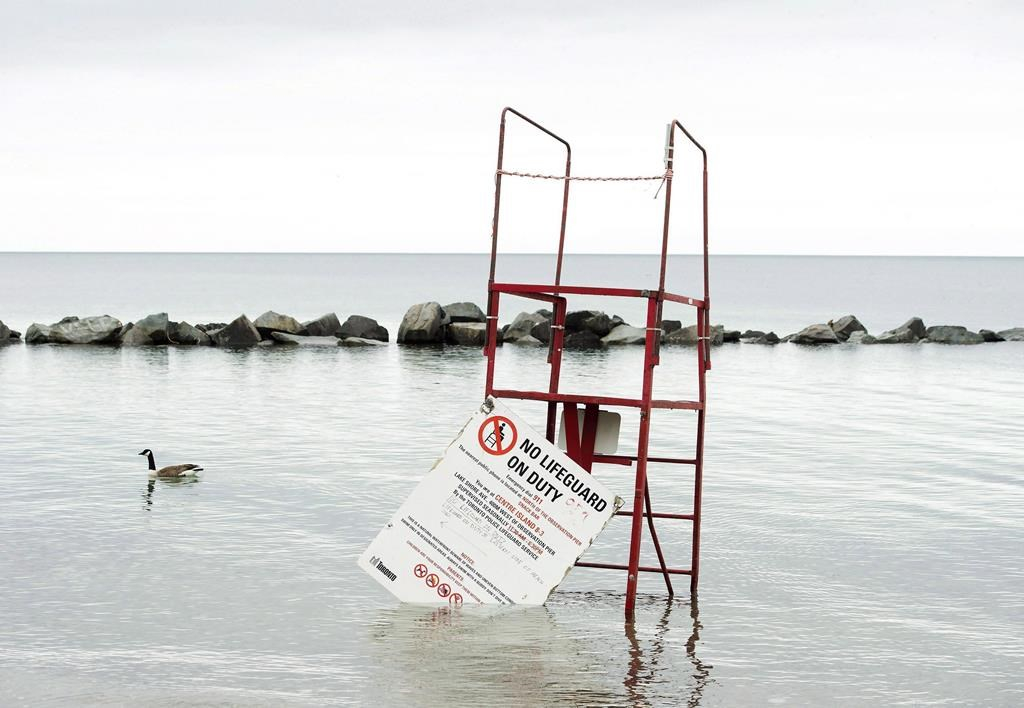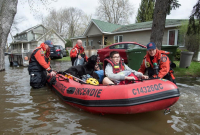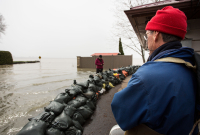Support strong Canadian climate journalism for 2025
A new report shows high water levels and floods are still pounding Central Canada and causing “severe hardships” to residents and business owners, almost three months after a joint Canada-United States body warned of “major coastal flooding.”
The International Lake Ontario-St. Lawrence River Board announced July 21 that “heavy rains and storms have been frequent and widespread June through mid-July," compounding the effects of spring flooding that affected thousands of homes in Ontario and Quebec and provoked the deployment of hundreds of troops.
Water is rushing into Lake Ontario at "close to record-high values for this time of year," the board has said, complicating an effort it began in June to drain the lake at "unprecedented" rates.
It says it's trying to drain the lake as fast as it can, but can't go any faster without causing major problems to people, the environment and commerce. Hundreds of residents are still at risk of flooding between the Montreal and Trois-Rivières areas, it said, while shoreline erosion is possible and the safety of ships is in jeopardy.
Yet this balancing act has proved frustrating for some residents. "Your ability to forecast is very suspect," wrote one user on the board's Facebook page. Others have echoed that sentiment.

New York Governor Andrew Cuomo said commission made 'mistakes'
On July 6, New York Governor Andrew Cuomo said there were “mistakes” committed by the International Joint Commission that oversees the board. The governor didn't elaborate on what those mistakes were, and questions to his office weren't returned before publication.
“The board understands that severe hardships continue to be incurred by Lake Ontario residents and business owners alike due to continuing high lake levels, associated flooding and related damages,” its statement reads.
Cuomo also called on U.S. President Donald Trump to "appoint qualified people" to replace two American commissioners who have offered their resignations. A Canadian government official describes their offers to resign as standard diplomatic practice when administrations change.

System still dealing with high water levels
May was the wettest on record, and April was the second wettest on record, while June and July had “well above average” wet conditions, according to Derrick Beach, a water resources engineer with Environment and Climate Change Canada and the spokesman for the board.
In addition to displacing thousands, causing damage and creating a need for an emergency military response, the floods in Central Canada also shut down major summer tourist attractions.
The Toronto Islands reopened to the public July 31 after being closed for months and losing an estimated $8 million in revenue. And after expecting record boating traffic, the Rideau Canal in Ottawa has instead been forced to close several lockstations.
Much of the Lake Ontario-St. Lawrence River system is still dealing with high water levels, the board said.
“Certainly there has been flooding around Lake Ontario, and with the higher water generally there is increased erosion on certain areas,” said Beach.
“Generally the properties around the lake have experienced some flooding, and some businesses have incurred some hardships due to that, and of course property owners as well.”

Climate change seen as factor in flooding events
The extended period of high water is in line with warnings from both politicians and Canadian scientists, who have anticipated that climate change will increase the “frequency and severity of extreme weather events” such as floods, heat waves and droughts.
In May, after touring flooded areas in Gatineau, Que., Prime Minister Justin Trudeau said Canadians will need to understand that “bracing for a 100-year storm is maybe going to happen every 10 years now, or every few years," in an apparent reference to the accelerating pace of climate change.
Public Safety Minister Ralph Goodale, who called the Gatineau flooding a “large-scale disaster,” has also noted how “the phenomenon of climate change” is responsible for “the pace” of extreme weather events “clearly accelerating.”
The Trudeau government, which is moving to enact its plan to combat the destructive effects of climate change through cracking down on methane gas, taxing fossil fuels and pricing industrial carbon pollution among other efforts, has also started to steer toward rewarding more climate-resilient infrastructure.
When evaluating which major transportation projects to fund as part of a new endeavour, Transport Minister Marc Garneau said in July that if projects are built to withstand climate disasters, they’d have a better chance of getting funding.

Decision on water management proves controversial
The board is in charge of regulating the flow of water from Lake Ontario into the St. Lawrence River using the Moses-Saunders Power Dam near Cornwall, Ont.
Although water levels have declined slightly since the record-smashing peak in late May, the board said last week that it kept draining the lake at a high rate because water has kept flowing into the system at above-average rates.
Nevertheless, it says it can’t boost the outflow any more or it would “jeopardize the safety of ships or halt commercial navigation” as well as put the St. Lawrence shoreline at risk of erosion and further flooding.
“These were extraordinary rainfall events,” said Beach. “There’s only so much physical capacity that the system will allow to drain.”
Some residents have become suspicious of the commission's switch in December 2016 to a newer plan to drain the lake, called Plan 2014, which replaces earlier directives from the 1950s.
"Can you please post a chart demonstrating what these water levels would have been under Plan 1958?" asked one Facebook user. "Since spring, the water levels would be identical to this point," the board replied.
Another user asked whether the older plan would have been able to be more responsive to the spring flooding.
The board responded that "during a 1-2 week period in March" it's possible the older plan would have resulted in lower levels, but that since the end of April it has been determining outflows directly, so it wouldn't have mattered.
It's not clear whether this is what Cuomo was referring to when he said on July 6 that the commission’s actions "should be studied with the advantage of hindsight" in order not to "have the same mistakes again.”
"There's no doubt that God put the water there. Everybody agrees with that. An extraordinary amount of rain that filled the lake," said Cuomo. "The second question was, what do the regulators do, and how did they react as they saw the water level rising?"
Cuomo's office directed questions about the governor's comments to the New York State Department of Environmental Conservation. A spokesman for the department acknowledged he had been notified of questions but did not respond in time for publication.
Asked for comment on the governor’s statements, board spokesman Beach said the board was “drawing on all of its resources and available technological support to provide the best information” that can reduce water levels the fastest.
“The intent of these high outflows are to provide all possible relief to Lake Ontario shoreline property owners, boaters, and other affected interests, while balancing the impacts on other affected stakeholders in the system.”
U.S. commissioners offer resignations
Cuomo also asked Trump to "evaluate and appoint qualified people" to the commission. U.S. chair Lana Pollack and U.S. commissioner Rich Moy have offered their resignations.
They will be staying on until the Trump administration appoints replacements, the board has said, which are subject to U.S. Senate confirmation. Pollack was appointed in 2010 and Moy in 2011, both by former U.S. president Barack Obama.
The board said their offers to resign are typical when presidential administrations roll over.
“It is common diplomatic practice in the U.S. for politically appointed representatives such as ambassadors, commissioners and secretaries to submit letters of resignation when a new administration takes office,” said Beach. “It is up to the new administration to decide when to accept the letters.”






Comments